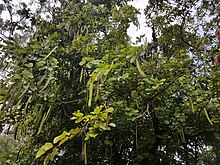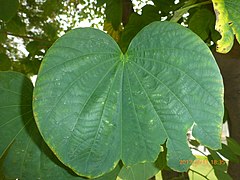Bauhinia purpurea
| Bauhinia purpurea | |
|---|---|

| |
| Tree with fruits from Mindanao, Philippines | |

| |
| Flower at Andhra Pradesh, India | |
| Scientific classification | |
| Kingdom: | Plantae |
| Clade: | Tracheophytes |
| Clade: | Angiosperms |
| Clade: | Eudicots |
| Clade: | Rosids |
| Order: | Fabales |
| Family: | Fabaceae |
| Genus: | Bauhinia |
| Species: | B. purpurea
|
| Binomial name | |
| Bauhinia purpurea | |
| Synonyms[1] | |
| |
Bauhinia purpurea is a species of flowering plant in the family Fabaceae, native to the Indian subcontinent and Myanmar, and widely introduced elsewhere in tropical and subtropical areas of the world. Common names include orchid tree,[2] purple bauhinia,[2] camel's foot,[2] butterfly tree,[2] and Hawaiian orchid tree.[citation needed]
Description
[edit]Bauhinia purpurea is a small to medium-size deciduous tree growing to 5.2 metres (17 ft) tall. The leaves are alternate, 10–20 centimetres (4–8 in) long and broad, rounded, and bilobed at the base and apex. The flowers are conspicuous, pink, and fragrant, with five petals. The fruit is a pod measuring 30 cm (12 in) long, containing 12 to 16 seeds.
Chemistry
[edit]A wide range of chemical compounds have been isolated from Bauhinia purpurea including 5,6-dihydroxy-7-methoxyflavone 6-O-β-D-xylopyranoside, bis [3',4'-dihydroxy-6-methoxy-7,8-furano-5',6'-mono-methylalloxy]-5-C-5-biflavonyl and (4'-hydroxy-7-methyl 3-C-α-L-rhamnopyranosyl)-5-C-5-(4'-hydroxy-7-methyl-3-C-α-D-glucopyranosyl) bioflavonoid, bibenzyls, dibenzoxepins, mixture of phytol fatty esters, lutein, β-sitosterol, isoquercitin and astragalin.[citation needed]
Distribution and habitat
[edit]Native to the Indian subcontinent and Myanmar, the species has been widely introduced elsewhere in tropical and subtropical areas of the world.[1]
In the United States, the tree grows in Hawaii, coastal California, southern Texas, and southwest Florida. Bauhinia × blakeana is usually propagated by grafting it onto B. purpurea stems.[citation needed]
Uses
[edit]The young leaves and flowers of Bauhinia purpurea are edible.[3] In the Philippines, B. purpurea is known as alibangbang[4] (lit. "butterfly"). The leaves have a citrusy and sour taste and are used either as a souring agent for sinigang and similar dishes, or, as a pickle condiment, in Philippine cuisine.[5][6][7]
Throughout Southeast Asia, B. purpurea and related species are also used in making poultices for treating swelling, bruises, boils, and ulcers. Various parts of the plant are also used in decoctions to treat fever and stomach ailments, as well as being used as an astringent.[3]
In Indian traditional medicine, the leaves are used to treat coughs while the bark is used for glandular diseases and as an antidote for poisons. The flowers are also used in pickles and curries and is regarded as a laxative.[3]
In culture
[edit]The plant is called Kānchan (কাঞ্চন) in Assamese, Odia,Rōkto Kānchan (রক্ত কাঞ্চন) in Bengali, Sinj alag in Santali and Taanki in Nepali.[citation needed]
Gallery
[edit]-
Bark
-
Leaf
-
Flowers
-
Flower close-up
References
[edit]- ^ a b c "Bauhinia purpurea L." Plants of the World Online. Royal Botanic Gardens, Kew. Retrieved 2020-05-27.
- ^ a b c d "Bauhinia purpurea". Germplasm Resources Information Network. Agricultural Research Service, United States Department of Agriculture. Retrieved 2 January 2018.
- ^ a b c "Bauhinia purpurea" (PDF). Agroforestree database. World Agroforestry Centre. Retrieved 26 November 2019.
- ^ Merrill, Elmer Drew (1903). A dictionary of the plant names of the Philippine Islands. Manila: Bureau of Public Printing, Department of The Interior. p. 128 – via University of Michigan Digital Collections.
- ^ "Alibangbang / Malabar Bauhinia". Market Manila. 7 August 2006. Retrieved 26 November 2019.
- ^ Vanzi, Sol (17 August 2017). "Sinigang secrets: Sinigang is life". Manila Bulletin. Archived from the original on 6 June 2019. Retrieved 26 November 2019.
- ^ Seidemann, Johannes (2005). World Spice Plants. Berlin, Heidelberg: Springer-Verlag Berlin Heidelberg. p. 64. ISBN 9783540279082.
External links
[edit] Media related to Bauhinia purpurea at Wikimedia Commons
Media related to Bauhinia purpurea at Wikimedia Commons- Phanera purpurea L., Purple camel's foot




